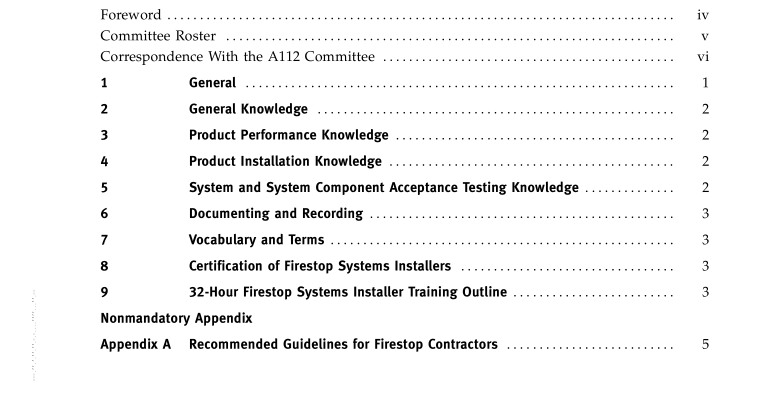ASME A112.20.2-2004 pdf free download.Qualification of Installers of Firestop Systems and Devices for Piping Systems
6 DOCUMENTING AND RECORDING The qualified firestop systems installer shall be able to identify and report the physical locations for the fol- lowing items on the “as-built” drawings:
(a) firestop system type
(b) insulation type, thickness, and compression
(c) type and size of penetration opening
(d) orientation of penetrating item
(e) annular space and dimension
(f) other items as required by the local jurisdiction
(g) firestop system and assembly rating
(h) types of penetrating items
7 VOCABULARY AND TERMS
The qualified firestop systems installer shall be able to demonstrate a basic working knowledge ofthe pertinent terms and vocabulary associated with firestopping systems covered by this Standard.
8 CERTIFICATION OF FIRESTOP SYSTEMS INSTALLERS
8.1 Overview Certification to this Standard shall be through an ISO/ IEC 17024 ANSI-accredited third party certifier. Certification shall include the successful completion of a mini- mum 32-hr training course (outlined in para. 9) that includes a written and a practical examination covering all facets of this Standard.
8.2 Practical Experience The certified firestop installer shall have a minimum of four (4) years of documented practical experience, recognized by the ISO/IEC 17024 ANSI-accredited third party certifier, in the installation of piping systems.
8.3 Recertification Certification shall be renewed a minimum of every five (5) years. The qualified firestop systems installer shall have at least eight (8) hr of continuing education prior to recertification 9 32-HOUR FIRESTOP SYSTEMS INSTALLER TRAINING OUTLINE The 32-hr training requirement (para. 8) shall include instruction, as a minimum, in the following topics:
(a) Session One (8 hr)
(1) history and background of fires (MGM, etc.)
(2) fire dynamics
(a) sources of combustion
(b) ignition sources
(c) smoke migration and stack effect/air movement
(d) fire development and spread in multistory buildings
(e) fire development and spread in single story buildings
(f) “fire triangle”
(g) basic theory of combustion
(h) methods of heat transfer
(i) “flashover”
(3) principles of fire protection
(a) detection
(b) containment and suppression
(c) building codes and firestop protection
(d) building design considerations
(e) understanding containment and compartmentalization
(f) the role of fire-resistance-rated construction
(4) hot gas, combustible gases, and toxicity
(a) thermal layering
(b) chemical asphyxiates
(c) toxic gases
(d) combustible gases
(5) test methods for firestop systems and fire-resistance-rated construction
(a) ASTM E814/UL 1479
(b) ASTM E119/NFPA 251/UL 263
(6) rating of fire-resistance-rated barriers
(a) hourly ratings
(b) flame penetration ratings (F rating)
(c) temperature transmission ratings (T rating)
(d) air (smoke) leakage rating (L rating)
(e) through penetration
(f) membrane penetration
(7) identification of fire-resistance-rated barriers
(a) floor/ceiling assembly
(b) roof/ceiling assembly
(c) smoke barrier
(d) fire wall
(e) fire barriers
(f) fire partitions
(g) smoke partitions
(8) Material barriers
(a) concrete barriers
(b) gypsum barriers
(c) combination barriers
(d) wood
(e) masonry
(9) Piping systems
(a) piping materials
(b) joining and support
(10) Design consideration
(a) smoke-tight penetrations
(b) types of construction: combustible and noncombustible
(c) fire blocking and draft stopping
(b) Session Two (8 hr)ASME A112.20.2 pdf download.ASME A112.20.2-2004 pdf free download
